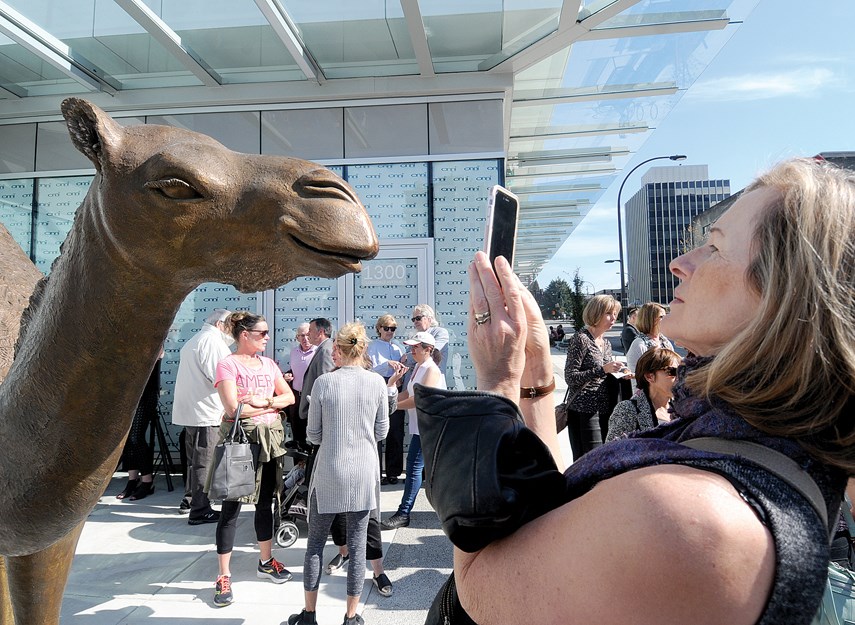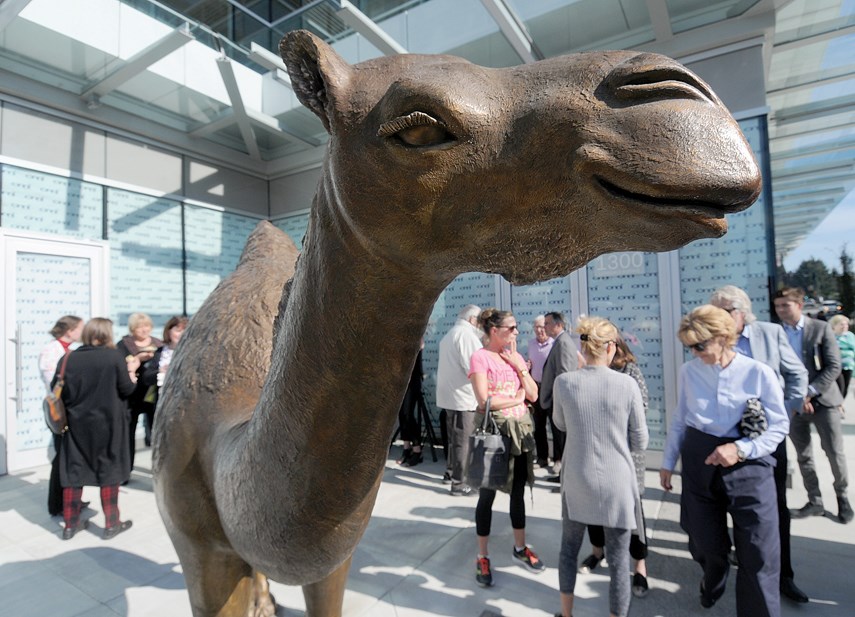A bronze camel sculpture was unveiled on Lonsdale Avenue and 13th Street last humpday, drawing cheers from many but leaving a few onlookers spitting mad.
The Lady is the handiwork of Myfanwy MacLeod, the artist best known for creating the 4,200-pound sparrows perched in Vancouver’s Olympic Plaza. The one-humped addition to Central Lonsdale’s animal population is life-sized, something MacLeod attributed to the project’s budget, which was $205,000 according to City of North Vancouver spokeswoman Connie Rabold.
MacLeod settled on the camel after discarding several statue ideas, including a giant head of Salvation Army founder William Booth. “Obviously they want something that’s going to relate to the site and to the context of North Vancouver ... I just kind of ignored that a little bit,” she said.
MacLeod was struck by the fact camels once trod through “the wilds of B.C.,” she said. “I also imagined that she was on her way back to wherever she came from,” she said. “On her way home.”
The sculpture displeased Central Lonsdale resident Bryan May, who wasn’t willing to let the camel pass through the eye of historical accuracy. “Wrong species, wrong geography, wrong history, zero cultural connection,” he said at a recent City of North Vancouver council meeting.
Given that the importation of camels to B.C. was a disaster, May questioned why “that failure” would be celebrated in the city centre. But that failure was precisely what was interesting, according to MacLeod, who said she tends to downplay monuments to heroism.
In 1862, a British Columbia entrepreneur had just enough gold dust in his eyes to think 23 camels represented the path to prosperity. Frank Laumeister and a few associates bought $6,000 worth of Bactrian camels in the hopes the smooth characters would need less care than a horse and shoulder a heavier load than a mule.
Once ferried from San Francisco to New Westminster, the Central Asia transplants immediately struggled on the Cariboo trail as booties fashioned of rawhide and canvas offered little comfort for the animals’ cracked and bleeding feet.
There was also trouble with temperament and odour, according to a website devoted to B.C. history.
“They bit and kicked everything that moved and smelled so foul that horses and mules would bolt their load and sometimes fall off the road to their deaths,” according to a report atcariboogoldrush.com.
Laumeister was stuck with animals that were eating whenever they weren’t spitting and vice versa, but he was also: “beset with . . . threats of lawsuits,” according to an account written by Kamloops archivist John Stewart.
Once the experiment ended, 12 surviving camels were sold or set free, according to Stewart. “Local folklore abounds with stories of people being frightened by camels throughout the southern Interior,” he wrote.
The longest living B.C. camel was owned by Henry Ingram, who likely worked as a driver on the Cariboo trail.
He took three camels to his farm in Grande Prairie, Alta. After selling 404 pounds of camel meat to the Hudson’s Bay Co. in 1864 in exchange for tools, he kept one camel, according to Stewart.
Every spring, the camel was sheared like a sheep, its hair used in pillows and mattresses. Adoring children frequently rode the “gentle animal.” In 1905, the last of the Cariboo camels “leaned against a tree and died on its feet,” Stewart wrote.

There’s just something about those animals famously described as “horses designed by committee,” MacLeod explained. “They’re kind of funny looking. They’re not pretty like horses.”
However, The Lady’s smile and voluminous eyelashes give it a coquettish expression.
As far as the one-hump versus two-hump drama, MacLeod said the dromedary decision was an esthetic choice. “I actually prefer the one-humped camel and I’m the artist so I get to make the decision,” she said with a laugh. “It’s called artistic licence.”
One of the less impressed onlookers complained the sculpture made him think of Florida’s Burmese pythons and Australia’s cane toads.
MacLeod said she liked the idea of introducing an animal that speaks to “waves of immigration.”
The Ladywas sculpted with one audience in mind, MacLeod said. “My audience is always small children. Basically, I’m happy if they’re happy.”
For Mayor Darrell Mussatto, The Lady is about making public space more animated and livable. At times, it also makes the public space more controversial, he said prior to the unveiling. “That’s what public art is all about.”
The artist contract was paid for by Onni Group as part of the developer public art program.



